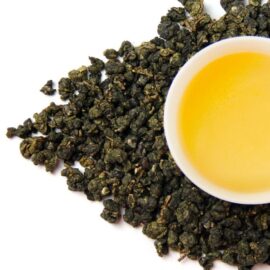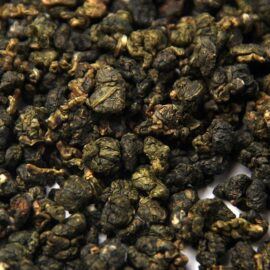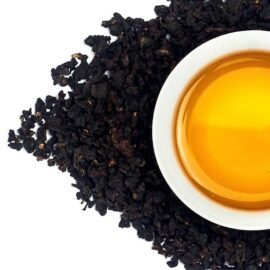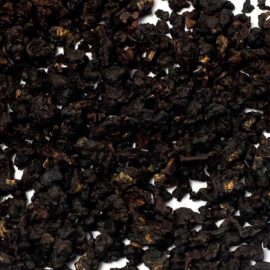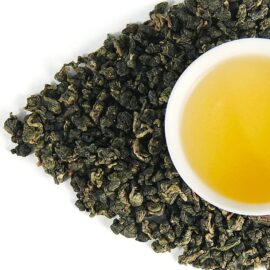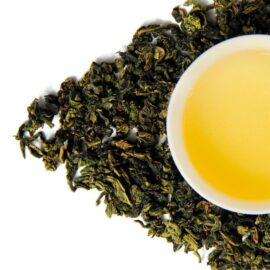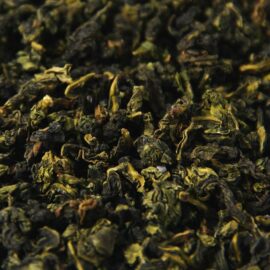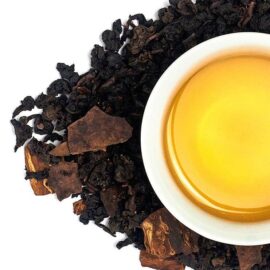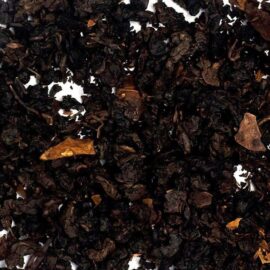-
- Rated 4.43 out of 5
Alishan Taiwanese Oolong (No. 600)
- Translation from Chinese: Oolong from Alishan Mountain Place, Date of Production: Alishan, Taiwan, 2024 Type: Taiwanese Oolong Appearance: Tightly rolled, vibrant green leaves Aroma: Floral, with hints of fresh grass and sweet cream Taste: Smooth and buttery, with a floral undertone Aftertaste: Long-lasting, creamy, and slightly sweet Infusion Color: Pale yellow-green Best Brewing Vessel: Ceramic gaiwan or thin-walled clay teapot
- 690₴ /50g
- Select options This product has multiple variants. The options may be chosen on the product page
-
- Rated 5.00 out of 5
Lao Cha Wang Aged Oolong Tea (No750)
- 826₴ /50g
- Select options This product has multiple variants. The options may be chosen on the product page
-
- Rated 5.00 out of 5
Lishan Taiwanese Oolong Tea (No1200)
- 1 320₴ /50g
- Select options This product has multiple variants. The options may be chosen on the product page
-
- Rated 5.00 out of 5
Tie Guan Yin, “Iron Bodhisattva” light Oolong (#800)
- Iron Bodhisattva Guanyin Place, date of production: Fujian, Anxi County, autumn 2023 Type: Southern Fujian Oolong Appearance: Spherical twist, beautiful green tea leaves Aroma: Long-lasting, rich, floral, with notes of jasmine, caramel, mown grass, lilac, and sweet delicate acacia Taste: Fulfilling, sweet, refreshing with delicate floral notes of blooming lilac Aftertaste: Long, refreshing, honey-like Color of the brew: Light honey…
- 880₴ /50g
- Select options This product has multiple variants. The options may be chosen on the product page
-
- Rated 5.00 out of 5
Ku Gua Lao Cha Wan Aged Pumpkin Oolong (#360)
- Lord of Old Tea in Bitter Gourd Place, Date of Production: China, Fujian Province Type: Aged Southern Fujian Oolong Appearance: Glossy dark chocolate-colored tea leaves, tightly rolled into spherical pellets, tea enclosed in the shell of a bitter gourd Aroma: Cozy aroma of warm rye bread crust, with a light oily nutty shade Taste: Deep, smoky, coffee-like, viscous and bitter,…
- 486₴ /50g
- Select options This product has multiple variants. The options may be chosen on the product page
“Dark Dragon”, “Turquoise Tea”, “Qing Cha” are the names of the same Chinese tea, which is known to connoisseurs as oolong tea. This is not a specific variety, but an extensive group of semi-fermented teas, the degree of fermentation of which varies from 20 to 60%. The Chinese call oolong tea the middle way due to the balance of taste and aroma. The taste combines black and red varieties, and notes of white and green teas are mixed in the aroma.
Oolongs are produced in two provinces of China (Fujian and Guangdong), and in Taiwan, from fully ripened juicy tea leaves, and not from their fluffy half-opened buds. For about an hour, the collected raw materials are dried, dried to remove excess moisture, and placed in shaded areas for further processing. Next, the so-called upholstery of the edges, or shaking, occurs, and the raw material can also spin in a special drum where the upholstery of the edges occurs when the tea leaves hit the special internal ledges. In this case, you need to ensure that the leaves do not break. This method involves the oxidation of leaves only along the edges and veins of the lit, which is called partial fermentation.
Real Chinese oolong in Ukraine is presented in the online store “Cha”. Our company is one of the few that offers high quality tea brought directly from China. You can buy original oolong tea in Kyiv, Odessa, Kharkov, Dnipro and other cities.
We offer tea with excellent taste characteristics, which has an exquisite aroma, which can be ordered online, on the company’s website. Oolongs are made from high quality raw materials. Due to the fact that we work without intermediaries, the price of tea is favorable for us.
Oolong Characteristics
Oolong, which is known to many as oolong, is a category that includes numerous varieties with different aromas and tastes. We can say that oolong is a way of processing tea leaves. There are several types of oolongs.
- Light fermented or light oolong.
- Heavy fermented or dark oolong.
Lightly fermented oolongs are made in Taiwan, south of Fujian
The raw materials for these varieties are leaves collected from bushes growing in mountainous areas. In the south of Fujian, light varieties of oolongs are produced.
Heavily fermented oolongs are produced in northern Fujian and Guangdong. For dark types of oolongs, raw materials from tree-like tea bushes growing in high mountain regions are used. Such leaves are very large, juicy, leathery, ideally curled during drying.
How oolongs are made
The collection of tea leaves for oolongs is carried out manually, without the use of machinery. Production after the collection of raw materials includes several successive stages. The stages of production of northern Fujian oolongs include:
- Collecting leaves.
- Drying.
- Shake.
- Semi-fermentation (curing).
- Roasting.
- Twist.
- Re-roasting.
- Bake.
- Laying out between bakes.
- Rebake (if required).
- Sort.
The main steps in the production of Taiwanese oolongs include
- Collecting raw materials.
- Drying.
- Shake.
- Fermentation (curing).
- Roasting.
- Swaddling
- Twist.
- Scatter roast.
- Re-swaddling, twisting.
- Drying, frying until done.
At the final stage, the finished tea is sorted, cooled and packaged.
